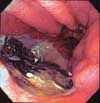Woman With Nausea, Emesis, and Abdominal Pain After Splenic Artery Embolization
A 68-year-old woman presents with recurrent nausea, vomiting, left upper quadrant pain, decreased appetite, and a 2.3-kg (5-lb) weight loss 1 month after she underwent selective splenic artery embolization for refractory thrombocytopenia secondary to hypersplenism.

Figure 1
A 68-year-old woman presents with recurrent nausea, vomiting, left upper quadrant pain, decreased appetite, and a 2.3-kg (5-lb) weight loss 1 month after she underwent selective splenic artery embolization for refractory thrombocytopenia secondary to hypersplenism. She has a history of severe primary pulmonary hypertension, cor pulmonale, atrial fibrillation, sick sinus syndrome that requires a pacemaker, and depression. Her medications include metoprolol, digoxin, diltiazem, furosemide, fluvoxamine, and continuous intravenous epoprostenol. She denies alcohol and tobacco use.
Vital signs are normal. The left upper quadrant and mid-epigastric region are tender on palpation. Results of a chemistry panel, liver function tests, and complete blood cell count are normal. Platelet count is 212,000/µL (normal, 142,000 to 362,000/µL), compared with 31,000/µL before splenic artery embolization.

Figure 2

Figure 3
A CT scan reveals complete liquefaction necrosis of the spleen and a few air bubbles within the fluid collection (Figure 1). Upper endoscopy shows a large, 5-cm, confluent ulcer bed on the proximal greater curvature of the stomach that extends to the fundus (Figure 2). Biopsy results demonstrate fundic-type gastric mucosa with marked acute inflammation, necroinflammatory debris, and granulation tissue--all consistent with an ulcer (Figure 3). Histologic findings are negative for Helicobacter pylori.
The patient is treated with pantoprazole (40 mg IV bid until she is able to tolerate the oral medication, then 40 mg PO bid), sucralfate (1 g PO qid), and a clear liquid diet. After a 2-week hospital stay, she is discharged. She is afebrile and can tolerate a soft mechanical diet, despite persistent left upper quadrant pain and mild nausea.
Three weeks after the initial upper endoscopy, a second study shows no change in the ulcer. However, the patient reports decreased abdominal pain and nausea, and she can tolerate a regular diet. Follow-up upper endoscopy, 2 months later, reveals complete resolution of the gastric ulcer.
COMPLICATIONS OF SPLENIC ARTERY EMBOLIZATION
Splenic artery embolization is a nonoperative therapy for hypersplenism that is reserved for patients in whom surgery poses high risk and those who have comorbid conditions that preclude splenectomy.1 Removal of the spleenimproves the hematologic status of patients with hereditary spherocytosis, thalassemia, idiopathic thrombocytopenia purpura, or congestive splenomegaly and of renal transplant recipients in whom azathioprine intolerance develops.2
Preoperative splenic artery embolization is recommended before standard splenectomy in patients with massive splenomegaly. It can reduce intraoperative blood loss and the need for transfusion while improving preoperative hematologic indices.3,4 However, transcatheter embolization of the spleen is associated with serious complications, including splenic abscess,5 splenic rupture,6 septicemia and pneumonia,7 and pancreatitis.8 Here I present the first reported case of a gastric ulcer as a complication of splenic artery embolization.
GASTRIC ULCERATION: A RARE COMPLICATION
The extensive blood supply to the stomach has historically made gastric ischemia an uncommon occurrence. In addition to minor and collateral arterial sources, which form a complex plexus to the stomach, there are 5 major direct arterial sources, including the right and left gastric, right and left gastroepiploic, and short gastric arteries.9 The gastric ulcer in this patient probably resulted from embolization of the short gastric arteries that branch off the splenic artery. The short gastric arteries supply the fundus and portions of the greater curvature of the stomach.
Few cases of gastric ulceration after splenectomy have been reported.10,11 In a case of a bleeding gastric ulcer that had developed 2 weeks after preoperative splenic artery embolization and splenectomy for massive splenomegaly, surgical intervention was required to control the bleeding. The ulcer was located on the proximal greater curvature on the luminal side of a suture-ligated short gastric vessel.4
In another case of a 14-year-old boy with massive gastric bleeding 8 months after a splenectomy, emergent surgery revealed an abscess in the former splenic site that had eroded transmurally into the gastric lumen along the greater curvature.12 A partial gastrectomy of the involved stomach was performed; the patient had a complete recovery several weeks later.
In the case presented here, right-sided heart failure was the most likely cause of the congestive splenomegaly. Splenectomy had been excluded because of the patient's underlying severe pulmonary hypertension. Histologic examination of biopsy specimens revealed no full-thickness gastric wall involvement or evidence of a gastric fistula or perforation from a splenic abscess. Thus, splenic artery embolization was determined to be the cause of this patient's large gastric ulcer.
References:
REFERENCES:
1.
Maddison FE. Embolic therapy of hypersplenism.Invest Radiol. 1973;8:280-281.
2.
Poulin EC, Mamazza J, Schlachta CM. Splenicartery embolization before laparoscopic splenectomy.An update. Surg Endosc. 1998;12:870-875.
3.
Fujitani RM, Johs SM, Cobb SR, et al. Preoperativesplenic artery occlusion as an adjunct for highrisk splenectomy. Ann Surg. 1988;54:602-608.
4.
Hiatt JR, Gomes AS, Machleder HI. Massivesplenomegaly. Superior results with a combinedendovascular and operative approach. Arch Surg.1990;125:1363-1367.
5.
Castaneda-Zuniga WR, Hammerschmidt DE,Sanchez R, Amplatz K. Nonsurgical splenectomy.AJR. 1977;129:805-811.
6.
Wholey MH, Chamorro H, Rao G, Chapman W.Splenic infarction and spontaneous rupture of thespleen after therapeutic embolization. CardiovascRadiol. 1978;1:249-253.
7.
Witte CL, Ovitt TW, Van Wyck DB, et al. Ischemictherapy in thrombocytopenia from hypersplenism.Arch Surg. 1976;111:1115-1121.
8.
Spigos DG, Jonasson O, Mozes M, Capek V. Partialsplenic embolization in the treatment of hypersplenism.AJR. 1979;132:777-782.
9.
Brown RB, Derr JW. Arterial blood supply of thehuman stomach. Arch Surg. 1952;64:616-621.
10.
Martinez CA, Waisberg J, Palma RT, et al. Gastricnecrosis and perforation as a complication ofsplenectomy. Case report and related references.Arq Gastroenterol. 2000;37:227-230.
11.
Stallard S, McPherson SG. Gastric necrosisand perforation following splenectomy for massivesplenomegaly. Scott Med J. 1990;35:86.
12.
Oestreich AE. Postsplenectomy abscess leadingto acute gastric hemorrhage. Gastrointest Radiol.1978;3:157-159.